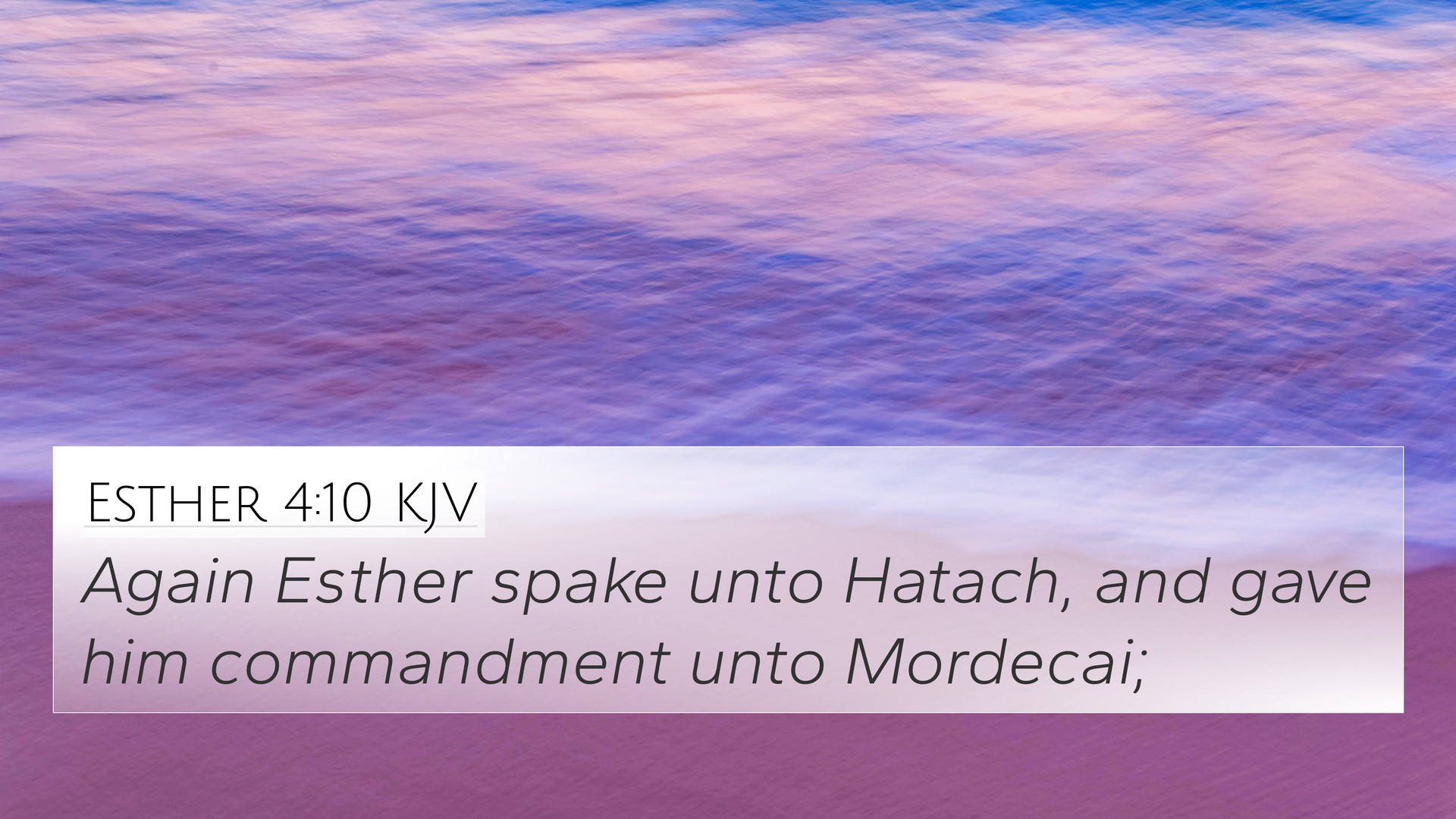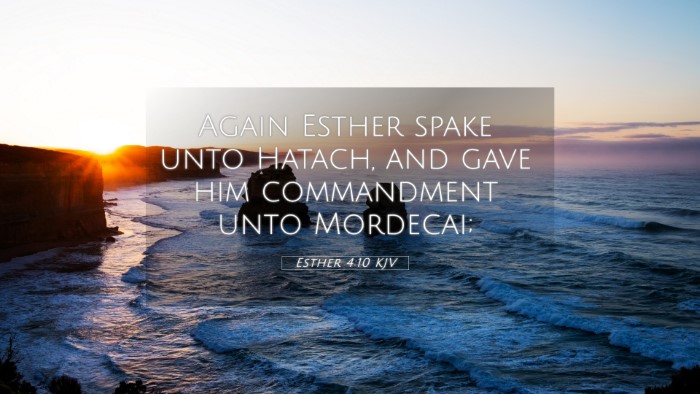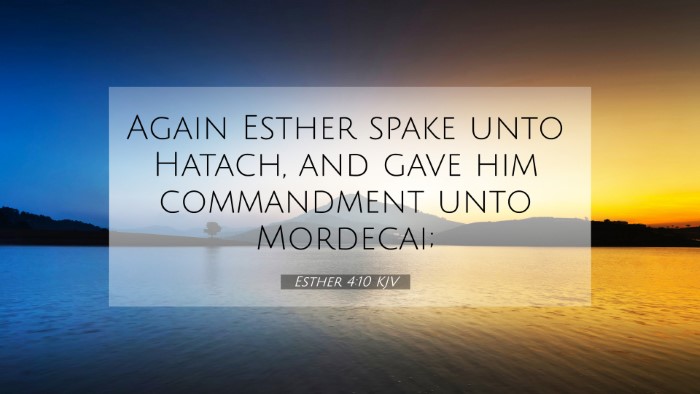Old Testament
Genesis Exodus Leviticus Numbers Deuteronomy Joshua Judges Ruth 1 Samuel 2 Samuel 1 Kings 2 Kings 1 Chronicles 2 Chronicles Ezra Nehemiah Esther Job Psalms Proverbs Ecclesiastes Song of Solomon Isaiah Jeremiah Lamentations Ezekiel Daniel Hosea Joel Amos Obadiah Jonah Micah Nahum Habakkuk Zephaniah Haggai Zechariah MalachiEsther 4:10 Similar Verses
Esther 4:10 Cross References
Again Esther spake unto Hatach, and gave him commandment unto Mordecai;
Uncover the Rich Themes and Topics of This Bible Verse
Listed below are the Bible themes associated with Esther 4:10. We invite you to explore each theme to gain deeper insights into the Scriptures.
Esther 4:10 Cross Reference Verses
No cross reference images were found in our system for this Bible passage.
Esther 4:10 Verse Analysis and Similar Verses
Understanding Esther 4:10
Esther 4:10 states, “Then Esther spoke to Hathach, and gave him a command for Mordecai.” This verse, although brief, opens a window into the much more extensive narrative of Esther where courage, identity, and divine intervention interlace.
Summary of Esther 4:10
This verse highlights the communication between Esther and Mordecai, reflecting the challenges they faced amidst the threat to the Jewish people. It emphasizes the role of messengers in conveying critical information during a time of great danger.
Commentary Insights
- Matthew Henry: Matthew Henry emphasizes Esther's obedient role in the unfolding drama, presenting her as both a figure of authority and vulnerability within her position as queen. He reflects on her willingness to act and the perceived danger of the situation.
- Albert Barnes: Barnes views the interaction as one of strategic importance. He points out Esther’s thoughtful approach in handling the delicate situation involving King Ahasuerus and her people's potential annihilation.
- Adam Clarke: Adam Clarke elaborates on the implications of Esther communicating with Mordecai through a messenger. He discusses the necessity of every individual in the narrative playing their assigned roles in God's sovereign plan.
Cross-References
Esther 4:10 connects with several key biblical passages, enhancing our understanding of this verse. Here are some significant cross-references:
- Esther 2:20: Esther's initial obedience to Mordecai and her concealment of her Jewish identity.
- Esther 3:2: The decree against the Jews, setting the stage for Mordecai's plea.
- Esther 4:16: Esther's later resolve to approach the king, illustrating her growth from fear to courage.
- Psalm 56:3-4: A reminder that trust in God can replace fear, resonating with Esther's situation.
- Proverbs 21:1: Demonstrates God's sovereignty over kings, relevant to Esther's plea to the king.
- DANIEL 2:21: God's control over times and seasons, emphasizing divine timing in Esther’s story.
- Romans 8:28: Assurance that in all things, God works for the good of those who love Him, reflecting God's overarching plan in the Book of Esther.
- James 1:5: The importance of seeking wisdom, paralleling Esther's need for guidance in her actions.
- 2 Timothy 1:7: God gives us a spirit of power, love, and self-discipline; relevant to Esther's courageous approach to her challenges.
- Philippians 4:13: "I can do all things through Christ who strengthens me," echoing Esther's empowerment in her critical mission.
Thematic Connections
Esther 4:10 and its surrounding verses speak to larger themes throughout Scripture:
- Courage: Esther embodies the courage required to confront authority for the sake of her people.
- Divine Providence: The unfolding story highlights God's providential care for His people even in dire circumstances.
- Identity: Esther’s struggle with her identity as a Jew in a foreign court resonates with other biblical themes of faithfulness amidst adversity.
Inter-Biblical Dialogue
The connections between Esther 4:10 and other biblical texts invite readers to engage in a broader interpretive approach. Comparative analysis, such as linking the Old Testament figure of Esther with New Testament themes of faith and divine sovereignty, enrich our understanding. For instance:
- Exploring Esther's story alongside the trials faced by Daniel in Babylon (Daniel 1-6) offers a perspective on maintaining faith and identity in a secular world.
- Analyzing Esther's leadership in the context of figures like Deborah (Judges 4) highlights women’s pivotal roles in biblical narratives.
- The overarching theme of salvation, seen in both Esther's intervention for the Jewish people and in Christ's sacrifice, showcases God's unwavering plan for redemption.
Practical Applications
For those studying Esther 4:10, several applications can be drawn, such as:
- Engaging in Courageous Advocacy: Consider how one might stand up for justice and advocate for others in difficult situations.
- Understanding Communication: Recognize the importance of wise communication in leadership and community.
- Embracing Identities: Reflect on personal identity within the context of community and faith.
Conclusion
Esther 4:10 serves as a pivotal point in the narrative of Esther, highlighting both the urgency of the moment and the bravery necessary for action. Cross-referencing with related scriptures enriches our understanding and emphasizes the Bible's interconnected themes of courage, identity, and divine providence.


